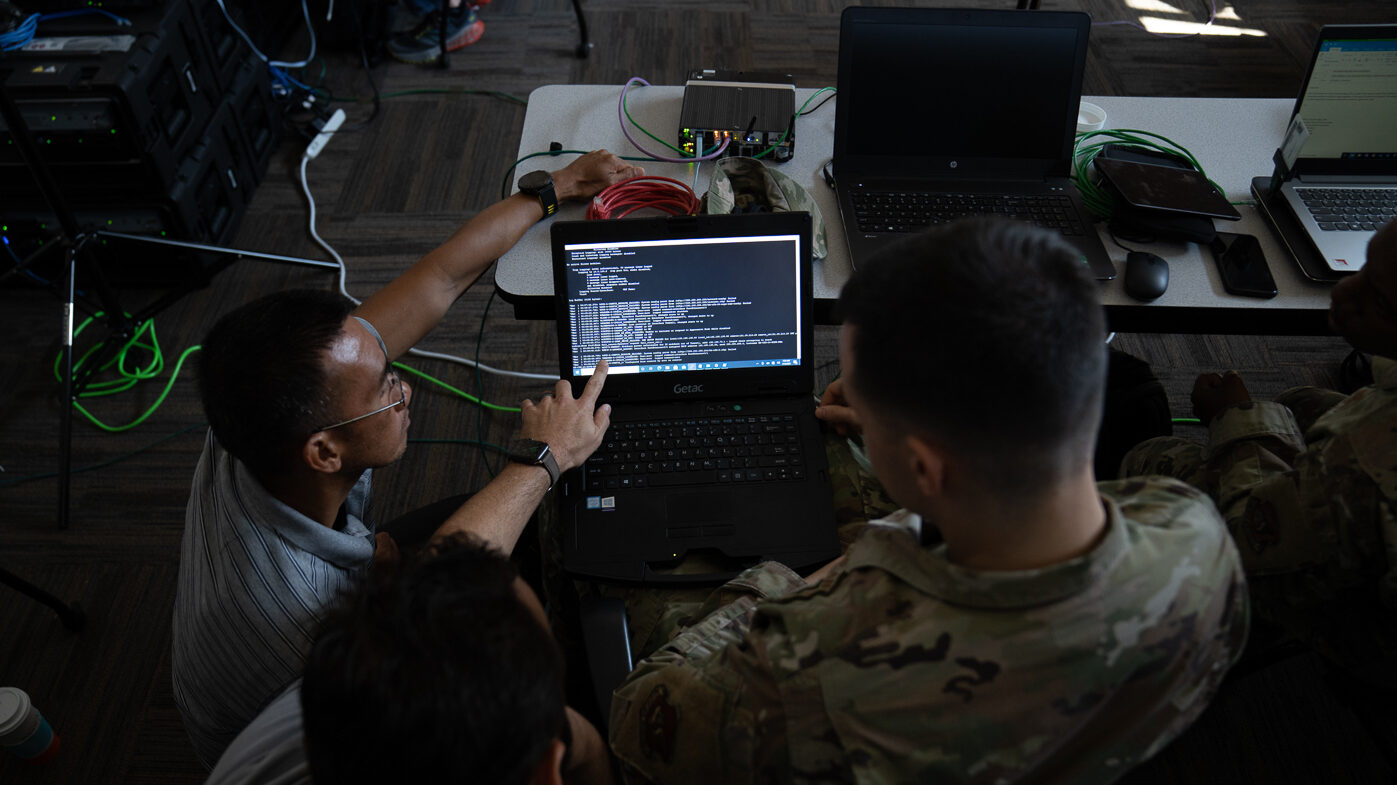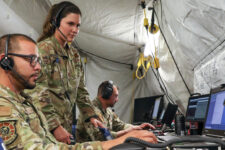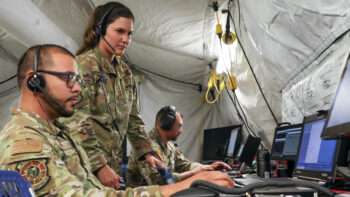
Members of the 56th Air and Space Communications Squadron at Joint Base Pearl Harbor-Hickam operate cyber systems using a Enhanced communications flyaway kit during the Global Information Dominance Experiment 3 and Architect Demonstration Evaluation 5 at Alpena Combat Readiness Training Center, Alpena, Michigan, July, 12, 2021. (U.S. Air Force photo by Tech. Sgt. Amy Picard)
WASHINGTON — The Defense Department’s biggest big-data system, Advana, will move from its current contracting vehicle to a new model open to a wider range of potential vendors, officials announced today. It’s a contracting change they hope will allow technical upgrades that let the increasingly popular platform grow to meet more varied needs from a wider population of users.
“Advana was kind of a walled garden, [with] a single prime integrator,” a senior defense official told Breaking Defense ahead of the formal announcement. But that approach, run through the GSA’s FedSIM service, no longer worked so well, since Advana had grown from a specialized accounting tool for the Pentagon comptroller to tracking financial, program management, and logistical data for roughly 100,000 users.
As Defense One reported, there’ve been complaints of often-burdensome procedures to bring on new sources of data, and in a leaked June 3 memo, the Pentagon’s Chief Digital & AI Officer had put a “pause” on short-term Advana upgrades, pending a more comprehensive overhaul — which is what the CDAO announced this afternoon.
In an interview today, the senior officials said the system needed to evolve to keep pace with its own growing popularity.
“We’re kind of victims of our own success,” one official told Breaking Defense in an exclusive interview ahead of this afternoon’s public announcement. “[So] we’re moving into more of an interoperable ecosystem of data and platform of apps and data and platforms … to lower the barrier for new entrants, from software developers to data infrastructure providers to data services.”
“That’s really the only way we get to sufficient scale,” the official said.
In its announcement today, CDAO said, “As the Advana platform scales to meet growing needs of the Department, CDAO’s acquisition approach is evolving in parallel to allow for increased creativity, innovation, and flexibility to meet unique customer needs.”
Open DAGIR: The New CDAO’s New Plan
Opening up Advana to multiple vendors this way is part of a broader reworking of DoD data and AI, known by the acronym Open DAGIR, that’s becoming the signature initiative of the new Chief Digital & AI Officer, Radha Plumb.
The overarching goal, Plumb told Breaking Defense in an exclusive interview last month, is to get more competition, diversity and interconnection in the DoD’s data systems, from the back office to the battlefield.
“Open DAGIR is about creating the right pathways to bring the best industry solutions and technology into our enterprise infrastructure to support the warfighter,” Plumb said in a new statement to Breaking Defense this afternoon.
In June, CDAO awarded Palantir contracts worth up to $513 million to expand its Maven intelligence AI and bring in third-party software tools. Now, Plumb said, “our second line of effort under Open DAGIR is focused on our Advana Analytics and Data Platform, a critical capability for driving advanced analytics and AI applications adoption across the joint force.”
Advana, short for “advancing analytics,” began as a bespoke bookkeeping tool in the Pentagon comptroller’s unending battle to pass a fiscal audit, co-developed by DoD and consultancy firm Booz Allen Hamilton. But Advana proved so useful and so adaptable that more and more users fed it more and more data for more and more functions, tracking everything from protective gear during the COVID crisis to aid to Ukraine.
As early as 2021, Deputy Secretary Kathleen Hicks had officially declared [PDF] that “Advana … is the single enterprise authoritative data management and analytics platform for the Secretary of Defense. … The use of other data management and analytics platforms must be approved by the DoD CDO [Chief Data Officer]. Senior leader forums, including the Deputy’s Management Action Group and Deputy’s Workforce Council, will rely on the Advana platform.”
Those are some high-profile users, and the officials who spoke to Breaking Defense made sure to emphasize that the new approach to Advana wouldn’t compromise its current functions for its current customers.
“We’re making some changes to the platform, [but] we’re not expecting adverse impacts to our customers” who can keep using their existing tools and data, one of the officials said. And in the long term, the official went on, “this is going to help us accelerate improvements and enhancements, [new] tools and software and services.”
“It’s not that we were not making progress,” they said, “[but] we think we can move even faster.”
So how fast will the new and improved Advana materialize? The officials said CDAO is still thrashing out a lot of the specifics, such as what protections to put in place for vendors’ intellectual property, which contract structures to employ, and which partner agencies across the DoD to work with. (The Maven Smart System contract, for instance, was let through the Army Contracting Command.)
RELATED: First version of all-service battle network is ‘real and ready now’: Hicks
Industry’s first window into CDAO’s detailed ideas for Advana will come next week, on Tuesday. The briefing will be part of a previously announced industry day for the quarterly Global Information Dominance Experiments (GIDE), which are building the Pentagon’s new all-service command and planning system, known as CJADC2. A more Advana-specific industry day will follow in the fall.
While CDAO oversees both GIDE and Advana, the two projects to date have been distinct, with GIDE focusing on data for military operations worldwide and Advana focusing on backoffice functions. But, Plumb told Breaking Defense last month, military staffs often need the kind of logistical data that Advana tracks so well. So while the two systems still need to do different things for different kinds of users, they also need to be able to share information swiftly when required.
“Our warfighters don’t need that siloed,” one of the officials told Breaking Defense. “They don’t care about those [bureaucratic] constructs. They just need the information that they need to get the work done for the nation.”





















